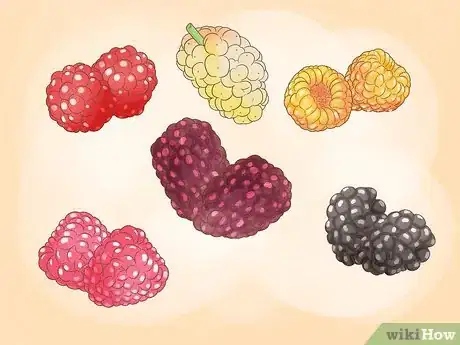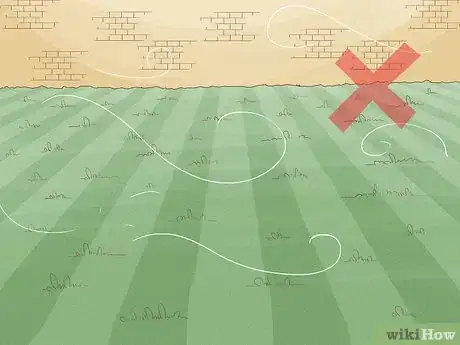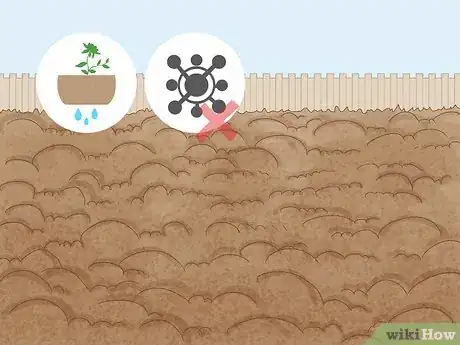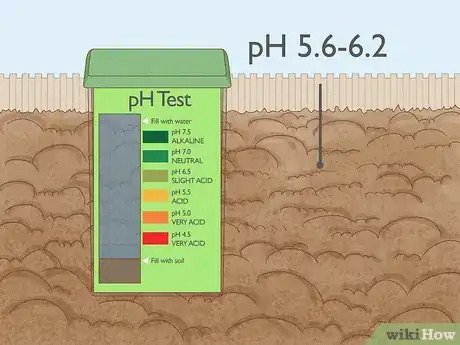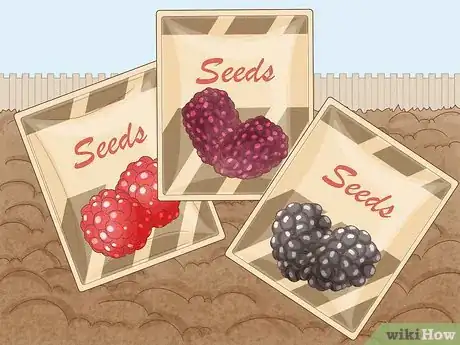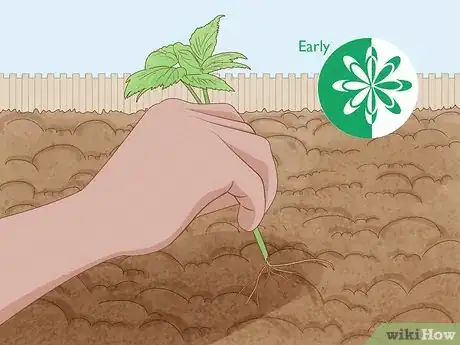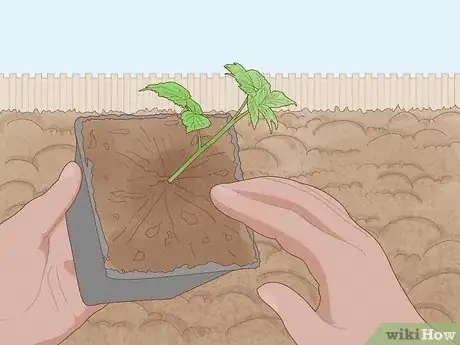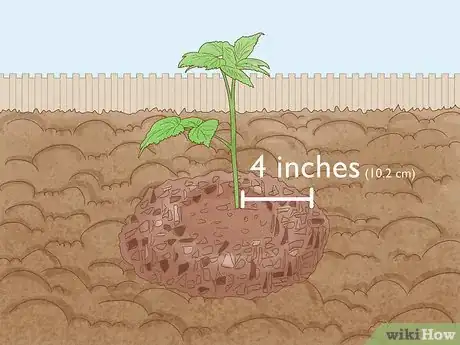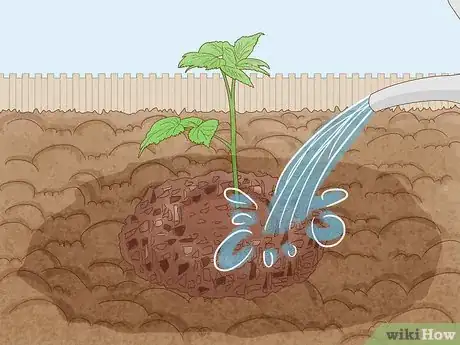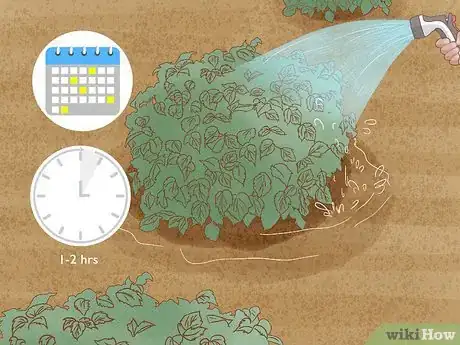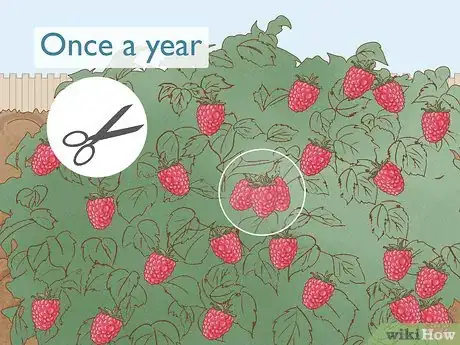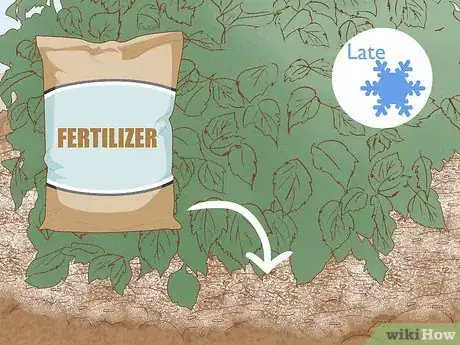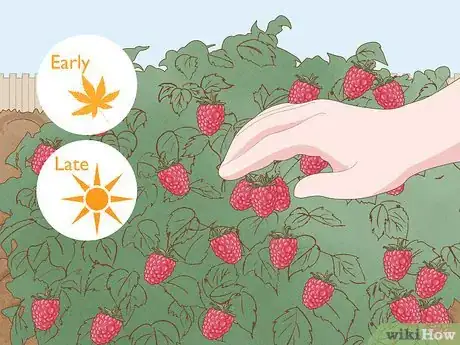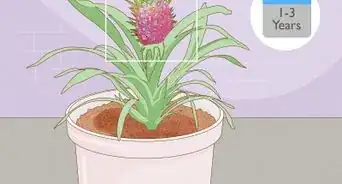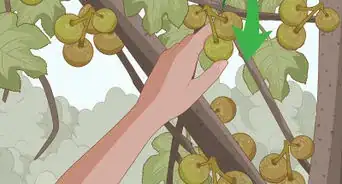This article was co-authored by Maggie Moran. Maggie Moran is a Professional Gardener in Pennsylvania.
There are 11 references cited in this article, which can be found at the bottom of the page.
This article has been viewed 121,047 times.
Nothing says "summer" quite like the taste of a sweet, juicy raspberry. Raspberries are relatively easy to grow in both cool and warm climates as long as they get full sunlight, which they require to thrive. Raspberries come in red, yellow, and black varieties that ripen at different times of the year, usually between late summer and fall.[1] Choose one of these varieties for your berry growing purposes, create the right conditions for growing, plant your raspberries, then care for them and harvest their fruit.
Steps
Choosing a Variety
-
1Educate yourself on the differences between fruit colors. Raspberries come in three different colors: red, yellow, and black. Some variants of black have more of a purplish-black hue. Each color has a different general flavor profile and level of hardiness.
- In most cases, you'll find that red and yellow raspberries are the sweetest colors, especially compared to black ones, which have a deeper, richer flavor.
- Red raspberries may want to be prioritized for beginning growers. Generally, these can be counted on to be the most hearty of the three colors.[2]
- Black raspberries are the most difficult of the three colors to maintain. These are more susceptible to disease and environmental changes.[3]
-
2Learn about the two main varieties. Raspberries are either summer-bearers or ever-bearers. Summer-bearers only bear one crop per season during summertime. Ever-bearers, on the other hand, produce one harvest in summer and another in the fall.[4]
-
Popular summer-bearers:
- Latham (round, dark red fruit)
- Meeker (deep red, extremely sweet, high sugar content)
- Willamette (firm and slightly tart)
- Brandywine (large, purplish-black fruit)
- Black Hawk (deep black, juicy berry)
- Popular ever-bearers:
Advertisement -
Popular summer-bearers:
-
3Plant several varieties for a continual harvest. Select plants that bear fruit throughout the summer months and well into the fall. By doing so, you can create an ongoing harvest so you can have fresh raspberries throughout the growing season.
- One possible combination could be mixing Algonquin (ever-bearing) with Autumn Bliss (midsummer-bearing).
- Another summer-bearing only combo might include: Boyne (early summer), Citadel (midsummer), Encore (late summer) Double Delight (early fall), Durham (fall).[7]
-
4Consider your climate. When it comes to growing plants, climates are usually broken up into "hardiness zones." The lower the number of your zone, the colder its climate and (generally) the farther it is from the equator. Your hardiness zone can be looked up on the USDA website.[8]
- The zones that plants are best suited for are usually listed with their care information. For the best results in your plants, only choose plants rated for your zone.
- In northern areas, you should use hardier, more cold-tolerant varieties of raspberry, like Boyne, Nova, and Nordic.
- In southern climates, choose raspberries that can withstand high heat and potential dryness, like Dorman Red, Bababerry, and Southland varieties.[9]
Creating the Right Conditions for Growing
-
1Choose an area with full sunlight. Full sunlight, in gardening terms, means at least 6 hours of sun, but in some cases plants requiring full sunlight might need 8 or even 10 hours of light to thrive.[10] For raspberries, aim to expose them to as much light as possible.
- Warm sunshine has a tendency to improve the quality of raspberry fruit, making it juicier and more flavorful. Fruit with poor light might turn out stunted and shriveled.
- You may have to move garden or yard items that block the sun to your raspberries. Prune back trees or bushes that could block the sun.[11]
-
2Avoid windy areas. Although environmentally hardy, raspberry plants are susceptible to wind damage. Plant your raspberry plants near a fence or on the side of a structure to block the wind. Set up a wind block for plants by stringing a sheet or tarp between posts.
- Provide additional support for your berries by stringing two guidelines between two row-end T-trellises or V-trellises. Each line should be separated by 3½ ft (1.1 m) to create a space for the berries to grow, and should be about 3½ ft high.[12]
-
3Plan for adequate spacing. You'll be planting your raspberries in rows. Plan for, within a row, red and yellow varieties being separated by a distance of about 2 ft (.61 m). Black and purple varieties should be kept 3 ft (.91 m) from other same-row plants. Distance between rows should be between 6 and 24 in (15.2 and 61 cm).
- Spacing your plants adequately will help them receive the most sunlight possible, which will encourage the best possible harvest.[13]
-
4Ensure that the soil is well drained and disease free. Rich, well-draining, sandy loam soil will provide the best growing conditions for your raspberries. Improve your soil quality by using plant formulated soil and mixing in compost with it.[14] Avoid planting in low-lying areas where water may collect after a heavy rain. Standing water can contribute to mildew, mold, root rot, and other kinds of plant disease.[15]
- Although raspberries fare poorly in standing water or when overwatered, make sure water is easily available. Water supply is especially important during dry times of the season.
- Refrain from planting raspberries in soil previously used for bramble berries, tomatoes, potatoes, peppers, eggplants, or roses. These can leave behind diseases.
- Destroy any wild growing raspberries or blackberries within about 600 ft (183 m) of those you plant. Wild berries can also transmit diseases to your healthy berries.[16]
-
5Check the pH of the soil. Most berries do best in slightly acidic soil, and raspberries flourish with a pH rating between 5.6 and 6.2.[17] You can purchase pH testing kits at your local nursery or home center, but you might also check out other methods as well.
- You should be able to find soil pH testing forms, bags, and instructions at your local agricultural extension office as well.
- In most cases, you can easily lower the pH level of your soil by mixing granular sulfur with it. This is available at most nurseries and home centers.
Planting Raspberries
-
1Grow plants from seeds. Seeds should be sown according to their package instructions in a plastic peat pot with sterile soil that is low in nutrients at about mid-winter. Space seeds one inch apart and then use your finger to push them about an inch (2.5 cm) into the ground. Cover seeds with a thin layer of loose soil/sand and store them in a dim, cool place indoors.[18]
- Keep the seeds lightly moist with a spray bottle. Place the seeds outside in partial sunlight when temperatures reach at least 60ºF (15.6ºC).
- Seeds should should be transplanted into your garden after growing at least one inch in height and developing leaves.[19]
-
2Purchase grown raspberry plants, alternatively. You'll want these to be at least one year old. Cultivated plants come in two basic types: those with bare roots covered in plastic peat containers and tissue-cultured plants.[20]
- Check with the nursery or home center where you purchase seedlings to make sure they are certified disease-free and have been propagated from virus-indexed stock.[21]
-
3Plant the raspberries in early spring. This is the best time to plant both seedlings and grown plants. This will allow the ideal amount of time for maturation. Grown plants should bear fruit by the end of summer. For ever-bearers, expect to find fruit into fall as well. Feel free to add raspberry plants to your patch throughout the summer months.
- Check the weather report before planting. If there's a fear of frost or a temperature drop, you may want to keep already dormant plants in stasis by keeping them in a refrigerator. Plant these berries as soon as possible.[22]
- Lay down a layer of straw over your plants to protect them from frost. Use ground cover, like a tarp or sheet, to prevent frost damage. Remove tarps or sheets in the early morning.
-
4Loosen the roots and remove the plant from its container, if necessary. Plants simply in a root ball should be easy to free from their packaging. Tap plants in containers with the heel of your wrist. This will loosen the roots. Slide the plant out and catch the soil gently.
- Be careful not to handle your plants too roughly. Pulling at the stem or the roots can damage your plants.
-
5Spread out your raspberries plants. Within each row, separate red and yellow raspberry plants by a distance of 2 ft (.61 m) apart. Black raspberries will need at least 3 ft (.91 m) between each plant in a row. Be sure to keep about 6 to 24 in (15.2 to 61 cm) between rows when you are planting.
- Newly planted or freshly germinated plants will require about a year before they begin to fill out and can bear fruit.[23]
-
6Dig a small hole for each plant and insert it into the ground. This should be just deep enough to cover the roots without touching the lowest leaves. Place the plant in the hole and cover it with soil. Cover any exposed roots but avoid burying its foliage.
- The depth for raspberry plant holes is usually about 3 to 4 in (7.6 cm to 10.2 cm). Use a simple hand shovel to dig the holes.
-
7Add mulch to keep the soil moist and prevent weeds. Use your best judgement when mulching. You can add up to 4 inches (10.2 cm), but don't add so much that the berries struggle to grow among the mulch. Gardening mulch can be bought at most nurseries and home centers.
- Other common inexpensive substitutes for store bought mulch includes hay, leaves, or bark.
-
8Water the area thoroughly after planting. Alternatively, soak the roots of raspberries in water for an hour or two before planting.[24] Add a ½ tsp (2.5 ml) of a vitamin B1 growth stimulant per quart water the roots are soaking in for even better results from your planting.[25]
- Heavily watering after planting can help plants to recover from the shock of transplanting. At minimum, thoroughly water you plants after planting.
Caring for Raspberry Plants
-
1Water plants weekly. Generally, you want the soil around your plants to be damp in summer and dry in winter. A soaker hose, where water seeps out of a hose line to water plants, should provide enough moisture for your berries if used for an hour or two every week.[26]
- In some cases, like during heat or dry spells, you may need to water your berries more than usual.
-
2Prune your raspberries at least once per year. Training your plants by pruning them will encourage a rich and productive crop. Remove canes (stems) outside the 12 to 18 in (30.5 to 45.7 cm) total row width. Cut away any canes that are damaged, infested with insects, or appear diseased.
- For summer-harvest crops of red raspberries, cut down discolored, grayish canes after they have finished producing fruit. Leave new, healthy plants.
- For fall-harvest crops, cut off all the canes at ground level after they have finished producing fruit.
- For black raspberries, cut off the side fruit-producing branches after harvesting. Remove weak and untrained branches. When not producing, cut off small canes.
- Remove the smallest, ineffective canes from all plants in late winter. Ideally, three to six strong, healthy canes will remain after this process.
-
3Fertilize in late winter. You can apply a few inches of mature compost and/or an organic fertilizer, such as fish emulsion, to promote healthy, productive plants. A homemade, organic raspberry fertilizer might look like:
- Organic homemade raspberry fertilizer: 4 parts canola seed meal (or fish meal), 1 part dolomitic lime (to offset acidity in the seed meal), 1 part rock phosphate (or ½ part bone meal), 1 part kelp meal.[27]
-
4Harvest your raspberries in late summer or early fall. The berries should be rich in color and come free easily from the plant. Some varieties, however, offer a bit of resistance when being picked. Taste a few berries to determine if they are sweet enough to harvest. As the color darkens, the sugar level increases.[28]
- Harvest berries early in the morning when it is still cold outside. This prevents them from smashing as you pick them.
- Rinse your berries and eat them immediately after harvesting. Though raspberries will keep in the refrigerator for several days, they are best eaten fresh.
- Freeze extra raspberries for later use in baking. Try putting putting them in jams or preserves, pies, etc.[29]
Expert Q&A
-
QuestionWhat is the best soil for growing raspberries?
 Maggie MoranMaggie Moran is a Professional Gardener in Pennsylvania.
Maggie MoranMaggie Moran is a Professional Gardener in Pennsylvania.
Home & Garden Specialist Raspberries need a very well draining soil with a preferable pH range between 5.5 and 6.5.
Raspberries need a very well draining soil with a preferable pH range between 5.5 and 6.5. -
QuestionDo raspberries need a lot of sun?
 Maggie MoranMaggie Moran is a Professional Gardener in Pennsylvania.
Maggie MoranMaggie Moran is a Professional Gardener in Pennsylvania.
Home & Garden Specialist Most varieties require full sun to produce fruit, but there are a few varieties of raspberry that will do okay in partial shade.
Most varieties require full sun to produce fruit, but there are a few varieties of raspberry that will do okay in partial shade. -
QuestionWhat climate do you need to grow raspberries?
 Maggie MoranMaggie Moran is a Professional Gardener in Pennsylvania.
Maggie MoranMaggie Moran is a Professional Gardener in Pennsylvania.
Home & Garden Specialist The best climate for the growing season should ideally have a temperature range of 70-75 degrees fahrenheit.
The best climate for the growing season should ideally have a temperature range of 70-75 degrees fahrenheit.
Warnings
- And orange, rust-like affliction may affect your raspberry plants. If you see these on your plants, remove and destroy the plant.⧼thumbs_response⧽
- Mildew may occur on the plants. It can be recognized by its white powdery appearance. Treat mildew with lime-sulfur according to the products usage directions.⧼thumbs_response⧽
- Gray, mold-like fuzz on fruit means that it is rotten. Pluck rotten fruit off of the plant and throw it away or compost it.⧼thumbs_response⧽
References
- ↑ http://www.raspberries.us/varieties.htm
- ↑ https://extension.umaine.edu/publications/2066e/
- ↑ http://www.almanac.com/plant/raspberries
- ↑ http://www.almanac.com/plant/raspberries
- ↑ http://homeguides.sfgate.com/varieties-everbearing-raspberries-25040.html
- ↑ http://www.raspberries.us/varieties.htm
- ↑ http://www.raspberries.us/varieties.htm
- ↑ http://planthardiness.ars.usda.gov/PHZMWeb/
- ↑ http://www.rodalesorganiclife.com/garden/grow-your-own-raspberries/page/0/2
- ↑ https://www.meadowsfarms.com/Lawn-Garden-Care/Gardening-Tips-and-Information/Inserts-from-A-Handbook-for-Garnening-in-NOVA/What-Does-Full-Sun-Really-Mean.aspx
- ↑ https://extension.umaine.edu/publications/2066e/
- ↑ https://extension.umaine.edu/publications/2066e/
- ↑ http://www.rodalesorganiclife.com/garden/grow-your-own-raspberries/page/0/2
- ↑ http://www.finegardening.com/improving-clay-soils
- ↑ http://www.pennington.com/resources/fertilizer/gardening/recovering-from-root-rot
- ↑ https://extension.umaine.edu/publications/2066e/
- ↑ https://extension.umaine.edu/publications/2066e/
- ↑ http://www.rodalesorganiclife.com/garden/grow-your-own-raspberries/page/0/2
- ↑ http://homeguides.sfgate.com/grow-raspberries-seeds-26247.html
- ↑ http://www.rodalesorganiclife.com/garden/grow-your-own-raspberries/page/0/2
- ↑ https://extension.umaine.edu/publications/2066e/
- ↑ http://www.finegardening.com/how-grow-raspberries
- ↑ http://www.rodalesorganiclife.com/garden/grow-your-own-raspberries/page/0/2
- ↑ http://www.almanac.com/plant/raspberries
- ↑ http://www.finegardening.com/how-grow-raspberries
- ↑ http://www.finegardening.com/how-grow-raspberries
- ↑ http://www.finegardening.com/how-grow-raspberries
- ↑ https://extension.umaine.edu/publications/2066e/
- ↑ http://www.finegardening.com/how-grow-raspberries
About This Article
To grow raspberries, choose an area that gets at least 6 hours of sun per day and is protected from wind. Then, follow the instructions on the seed package to plant the seeds indoors in the winter time to be stored in a cool, dark space until they’re about 1 inch tall. Be sure to mist the plants daily to keep the soil moist. Plant the seedlings in early spring with about 2 feet between plants. Add mulch to the soil around the plants to prevent weeds and keep the soil moist after watering weekly. For more tips from our Horticulturist reviewer, including how to choose the best raspberry variety for you, read on!
